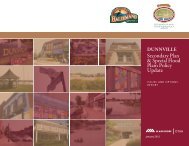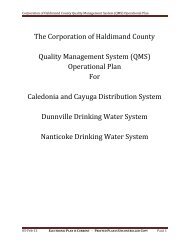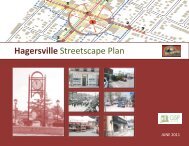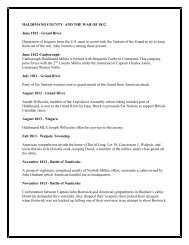Haldimand County
Table of Contents - Haldimand County
Table of Contents - Haldimand County
- No tags were found...
Create successful ePaper yourself
Turn your PDF publications into a flip-book with our unique Google optimized e-Paper software.
<strong>Haldimand</strong> <strong>County</strong><br />
DETACHMENT
OPP Strategic Plan<br />
2011-2013<br />
VISION:<br />
MISSION:<br />
Safe Communities… A Secure Ontario<br />
Policing excellence through our people,<br />
our work and our relationships.<br />
PUBLIC SAFETY<br />
RELATIONSHIPS<br />
WORKFORCE<br />
EFFECTIVENESS<br />
GOALS<br />
Excellence in the delivery<br />
of core police services through<br />
Intelligence-Led Policing.<br />
Strong, effective partnerships<br />
with our communities,<br />
stakeholders and colleagues.<br />
A sustainable pool<br />
of members with expertise,<br />
pride and dedication.<br />
Demonstrated efficiency and<br />
effectiveness operating in an<br />
increasingly complex and<br />
challenging policing environment.<br />
STRATEGIES<br />
1. Crime prevention and reduced<br />
victimization in our communities.<br />
2. Investigative excellence through<br />
Intelligence-Led Policing.<br />
3. Excellence in the response to and<br />
management of major investigations,<br />
critical incidents and emergencies.<br />
4. Save lives and reduce crime on our<br />
highways, waterways and trails.<br />
1. Develop and implement a coordinated<br />
approach to internal communications.<br />
2. Focus external communications to<br />
increase awareness of the OPP’s<br />
mandate, to our communities and<br />
stakeholders.<br />
3. Advocate for and support sustainable<br />
First Nations policing and safe<br />
communities.<br />
1. Support and enable continuous<br />
training, learning and development<br />
opportunities for our employees.<br />
2. Foster a culture of recognition and<br />
accountability through meaningful<br />
performance management.<br />
3. Promote a healthy workforce and<br />
healthy workplaces.<br />
1. Enhance information management<br />
with technology.<br />
2. Effective financial management and<br />
fiscal accountability.<br />
3. Embed environmental responsibility<br />
into our culture and our business<br />
practices.<br />
4. Continue to modernize equipment for<br />
all employees.<br />
• Crime Abatement Strategy statistics.<br />
• OPP Community Satisfaction Survey results.<br />
• OPS Employee Engagement survey results.<br />
• Uniform workload statistics.<br />
INDICATORS<br />
• Crime and traffic statistics.<br />
• Street checks.<br />
• Major investigation debriefings.<br />
• Major event evaluations.<br />
• Framework for Police Preparedness for<br />
• Ontario Public Service (OPS) Employee<br />
Engagement survey results.<br />
• Training opportunities provided to<br />
First Nations police services.<br />
• OPP member survey.<br />
• E-Learning statistics.<br />
• Human resource data systems.<br />
• Financial training opportunities.<br />
• Response to various inquests, inquiries and audits.<br />
• Integration of technology systems.<br />
• Infrastructure projects that meet environmental<br />
standards.<br />
Aboriginal Critical Incidents application.<br />
OPP VALUES: PROFESSIONALISM • ACCOUNTABILITY • DIVERSITY • RESPECT • EXCELLENCE • LEADERSHIP
<strong>Haldimand</strong> <strong>County</strong> Detachment 2011 Business Plan<br />
Ontario Provincial Police<br />
Table of Contents<br />
Page<br />
A Message from the Detachment Commander 2<br />
<strong>Haldimand</strong> <strong>County</strong> Environmental Scan 3<br />
Community/Stakeholder/Partner Consultations 6<br />
Strategic Plan Strategies 7<br />
2011-2013 Business Plan (Year 1) 8<br />
Safe Communities – A Secure Ontario 1
<strong>Haldimand</strong> <strong>County</strong> Detachment 2011 Business Plan<br />
Ontario Provincial Police<br />
A Message from the Detachment Commander<br />
This 2011 business plan outlines the broader goals of the <strong>Haldimand</strong> Police Services Board, Community<br />
and <strong>Haldimand</strong> Ontario Provincial Police (OPP) Detachment; all have worked in partnership to develop<br />
this plan. I continue to believe that the buttress of a safe community, which includes an increased quality<br />
of life, comes when there is a supported collaboration between the police and community. This<br />
collaboration focuses on working together to identify and resolve local community problems and issues<br />
and implementing measures to prevent their re-occurrence.<br />
The foundation of a safe and secure community is built upon localized interaction between the<br />
communities, politicians and police. Community safety and security is not kept primarily by the police, as<br />
necessary as we are; but rather public peace is more or less maintained through a sophisticated array of<br />
principles and other voluntary controls that communities place upon themselves. We, as police are only<br />
part of the solution, and thus, share with the community, the total responsibility of public peace, safety,<br />
security and quality of life. A success reflecting the latter is a significant drop in fatal and other collisions<br />
in 2010. Public education through the media supported with the “Strict is Fair” and “Drive Wise” initiatives<br />
deserve some of the accolades, however, the most important success factor I believe is that the<br />
community seems to “get it”. In other words, they, the community members themselves, are having the conversations about the<br />
impact of excess speed, distractions and drinking and driving on their community and their family. The success of the traffic collision<br />
reduction seems to be that community members are, themselves, responding to the tragic consequences of traffic collisions by<br />
obeying traffic laws to arrive safely at their destination.<br />
Police visibility continues to underpin our policing strategy in <strong>Haldimand</strong> <strong>County</strong>. Foot patrol and bicycle patrol have been significant<br />
components of this strategy and as a detachment we continue to get out of our police vehicles and “walk the beat”. Last year we saw<br />
the delivery of two All-Terrain Vehicles (ATV’s) to support policing activities in <strong>Haldimand</strong>. The ATV’s have been utilized in a variety<br />
of situations both proactively and reactively, with amazing success. We attribute saving the life of at least one community member to<br />
the utilization of these machines. As a result of the success witnessed, we plan to continue utilizing these vehicles in a variety of<br />
situations in 2011.<br />
As the senior OPP officer in <strong>Haldimand</strong> <strong>County</strong>, I commit to continuing the provision of clear, decisive and strong police leadership to<br />
the <strong>Haldimand</strong> <strong>County</strong> Detachment. We, as a policing presence and part of this community, will continue to participate in local<br />
events that provide for the betterment of the community, particularly assisting those that may be disadvantaged.<br />
Without exception I am humbled to provide pubic service to <strong>Haldimand</strong> <strong>County</strong> and as Detachment Commander, remain proud of our<br />
detachment members and their accomplishments. I look forward to continued success in 2011.<br />
John Periversoff<br />
<strong>Haldimand</strong> <strong>County</strong> Detachment Commander<br />
Safe Communities – A Secure Ontario 2
<strong>Haldimand</strong> <strong>County</strong> Detachment 2011 Business Plan<br />
Ontario Provincial Police<br />
CRIME AND TRAFFIC TRENDS:<br />
<strong>Haldimand</strong> <strong>County</strong> Environmental Scan<br />
Crime rates for the majority of community safety offences in 2010 decreased as compared to 2009. Of note were break and enter<br />
offences which decreased by 18% from 221 to 182. Other notable decreases were noted with assaults decreasing by 12%, and<br />
vehicle theft for a second straight year decreasing by 16% largely due to a special project to address this issue. General thefts also<br />
decreased by 16% and frauds were significantly reduced by 27%. Of concern were the number of sex related incidents which<br />
increased by 45% from 24 to 35, while the other increase was incidents of mischief which increased by 4% from 517 to 534.<br />
Investigative analysis has revealed that many of these offences are committed by persons with a criminal history, and they are<br />
frequently on some form of judicial release. The Intelligence-Led Policing - Crime Abatement Strategy (ILP-CAS) is a proactive<br />
initiative to ensure that persons who are on conditions imposed by the courts are complying with these conditions. Jurisdictions<br />
where this program has been implemented have seen significant decreases in their crime rates and <strong>Haldimand</strong> hopes to have similar<br />
success.<br />
<strong>Haldimand</strong> <strong>County</strong> experienced a reduction in motor vehicle collisions (MVC) for the third straight year in 2010. Our goal of reducing<br />
fatal collisions was met with dramatic results, five in 2010 compared to 10 in 2009. It remains tragic that we lost five community<br />
members in preventable collisions. Provincial Highways 3 and 6 are our main roadways, bringing ever-increasing truck traffic<br />
through the county headed to the industrial park at Nanticoke, where corporations such as Imperial Oil and Ontario Power<br />
Generation have large facilities, employing thousands. The growing tourism industry in <strong>Haldimand</strong>, brings in approximately 600,000<br />
people, contributes to increased traffic and related crowd control concerns. Events at either of our two racetracks routinely bring<br />
thousands of people to the area. The “Friday the 13 th “events in Port Dover cause significant traffic congestion problems in<br />
Hagersville and Jarvis.<br />
During the summer months, our provincial parks, campgrounds and recreational areas are filled to capacity. The cottage areas along<br />
Lake Erie are seeing rejuvenation, as people from the cities take advantage of their relatively low cost, proximity to home, and<br />
access to Lake Erie. Boaters and anglers are discovering the world-class fishing available in the Grand River and the excellent<br />
facilities available at area marinas.<br />
There has been an exponential growth in the use of ATV’s in our area. Once thought of as a farm utility vehicle, or a hunter’s tool,<br />
the ATV is now primarily a recreational vehicle that, unlike a snowmobile, can be used 12 months a year. The <strong>Haldimand</strong>-Norfolk<br />
ATV Safety Alliance continues to provide excellent ATV education to young people, which has yielded positive results. <strong>Haldimand</strong><br />
<strong>County</strong> Detachment acquired two ATV’s in 2010 which provided outstanding service to the <strong>County</strong> and are directly responsible for<br />
saving the life of at least one of our community members.<br />
Safe Communities – A Secure Ontario 3
<strong>Haldimand</strong> <strong>County</strong> Detachment 2011 Business Plan<br />
Ontario Provincial Police<br />
DEMOGRAPHICAL / SOCIAL / CULTURAL ENVIRONMENT:<br />
<strong>Haldimand</strong> <strong>County</strong>’s 1,252 square kilometers lies on the north shore of Lake Erie. Niagara Region borders us to the east and Norfolk<br />
<strong>County</strong> to the west. To the northeast lies the city of Hamilton, where many of our almost 46,796 residents work and shop. The<br />
Greater Toronto Area, and its millions of people, is less than an hour’s drive northeast of <strong>Haldimand</strong> <strong>County</strong>.<br />
Due to <strong>Haldimand</strong>’s agricultural heritage 53% of our total population still live in rural areas, with the remainder living in and around<br />
one of our five “urban” areas: Caledonia (9,600), Dunnville (5,600), Hagersville (2,550), Cayuga (1,650), Jarvis (1,450), and<br />
Townsend (924).<br />
Young people make up approximately 16% of our population, while approximately 17% are seniors. Both groups have specific and<br />
unique needs from community agencies, including the police. Local business owners and residents of our towns are concerned<br />
about youth loitering and causing mischief. Older people, especially in our rural areas, are concerned about break and enters and<br />
fraud. Elder abuse has also become more prevalent as our population ages.<br />
We have four high schools in our communities: Hagersville, Cayuga, Caledonia and Dunnville. Our principals and teachers,<br />
particularly at the high school level, feel it vitally important for police to have a consistent, positive presence in our schools.<br />
<strong>Haldimand</strong> <strong>County</strong> borders Six Nations of the Grand River Territory, as well as the Mississaugas of the New Credit First Nation, so<br />
the Aboriginal culture is very prevalent in this community.<br />
In the coming years, the OPP will prepare to respond appropriately and effectively to its changing communities.<br />
• By the year 2021, it is estimated that 19% of Canada’s population will be greater than 65 years of age.<br />
• Birth rates in Canada are falling below replacement levels – except in Aboriginal communities, where they are the highest in the<br />
country.<br />
• The population of visible minorities continues to increase – by the end of 2016, visible minorities will constitute 20% of the<br />
population of Canada.<br />
Safe Communities – A Secure Ontario 4
<strong>Haldimand</strong> <strong>County</strong> Detachment 2011 Business Plan<br />
Ontario Provincial Police<br />
POLITICAL ENVIRONMENT:<br />
The municipal government election this past year resulted in changes to the municipal council and Mayoral seat. The provincial<br />
government will hold its election this fall. An increased focus on road safety has resulted from new legislation targeting aggressive<br />
driving, street racing and increased penalties associated to impaired driving offences. This renewed focus on road safety will<br />
continue to be supported by all Detachment members, striving to maintain a high level of visibility throughout all of our communities.<br />
ECONOMIC ENVIRONMENT:<br />
<strong>Haldimand</strong> <strong>County</strong> is facing several economic challenges including the closing of a major industry in Dunnville. The closing of this<br />
major industry has had an impact upon local employment and related economic spin off. During these difficult economic times, it is<br />
paramount that the OPP ensures that it continues to provide effective service delivery within its funding envelope. This will present<br />
numerous challenges as there is a direct correlation between economic downturns and an increased demand for our services.<br />
ORGANIZATIONAL ENVIRONMENT:<br />
The OPP, as an organization, continues with the strategic plan for 2011-2013, which reflects our values of professionalism,<br />
accountability, diversity, respect, excellence and leadership. This over arching strategic plan determines direction, in part, from a<br />
corporate level on how the <strong>Haldimand</strong> <strong>County</strong> Detachment provides service to the community. A renewed commitment to road<br />
safety and the strategic delivery of related enforcement efforts is included.<br />
Safe Communities – A Secure Ontario 5
<strong>Haldimand</strong> <strong>County</strong> Detachment 2011 Business Plan<br />
Ontario Provincial Police<br />
Community/Stakeholder/Partner Consultations<br />
The OPP is committed to working in partnership with the communities we serve. We strive to provide effective and efficient services<br />
that address local needs, while fulfilling our provincial mandate for policing. During the development of this business plan, efforts<br />
were made to engage in discussions with our local community representatives to jointly determine key priority areas that need to be<br />
addressed.<br />
The following groups and agencies were consulted through special, individual and community meetings:<br />
• <strong>Haldimand</strong> <strong>County</strong> Police Services Board.<br />
• <strong>Haldimand</strong> <strong>County</strong> Council, Chief Administrative Officer and General Manager.<br />
• Chief of the Mississaugas of the New Credit First Nation.<br />
• <strong>Haldimand</strong> <strong>County</strong> Crown Attorneys.<br />
• <strong>Haldimand</strong> <strong>County</strong> Emergency Services Manager.<br />
• <strong>Haldimand</strong> Secondary School Principals.<br />
• Victim Services of <strong>Haldimand</strong>-Norfolk.<br />
• <strong>Haldimand</strong> <strong>County</strong> By-law Enforcement.<br />
• <strong>Haldimand</strong> Norfolk Resource Education and Counseling Help (REACH).<br />
• Community Service Organizations.<br />
• Community Policing Committees (CPC) of <strong>Haldimand</strong> <strong>County</strong>.<br />
The key issues identified through the community consultation process continue to be:<br />
1. Highway safety - speeding in particular.<br />
2. Youth issues - particularly mischief.<br />
3. Police visibility - foot patrol.<br />
4. Drugs.<br />
5. ATV / motorized snow vehicle (MSV) enforcement.<br />
Safe Communities – A Secure Ontario 6
<strong>Haldimand</strong> <strong>County</strong> Detachment 2011 Business Plan<br />
Ontario Provincial Police<br />
Strategic Plan Strategies<br />
Strategy Page #<br />
Effectiveness Workforce Relationships Public Safety<br />
1. Crime prevention and reduced victimization in our communities. 8<br />
2. Investigative excellence through Intelligence-Led Policing. 10<br />
3. Excellence in the response to and management of major investigations, critical incidents and emergencies. 11<br />
4. Save lives and reduce crime on our highways, waterways and trails. 12<br />
1. Develop and implement a coordinated approach to internal communications. 13<br />
2. Focus external communications, including an awareness of the OPP’s mandate, to our communities and<br />
stakeholders.<br />
3. Advocate for and support sustainable First Nations policing and safe communities. 15<br />
1. Support and enable continuous training, learning and development opportunities for our employees. 16<br />
2. Foster a culture of recognition and accountability through meaningful performance management. 17<br />
3. Promote a healthy workforce and healthy workplaces. 18<br />
1. Enhance information management with technology. 19<br />
2. Effective financial management and fiscal accountability. 20<br />
3. Embed environmental responsibility into our culture and our business practices. 21<br />
4. Continue to modernize equipment for all employees. 22<br />
14<br />
Note - Numbering does not indicate order of priority<br />
Safe Communities – A Secure Ontario 7
<strong>Haldimand</strong> <strong>County</strong> Detachment 2011 Business Plan<br />
Ontario Provincial Police<br />
2011-2013 Business Plan (Year 1)<br />
Strategy – Crime prevention and reduced victimization in our communities.<br />
Situational Assessment: Crime Prevention, the absence of crime, and the reduction of victimization are the key principles mandated<br />
under the Police Services Act. We achieve this through various crime prevention programs and initiatives, and by utilizing<br />
community support agencies including Victim Services. We have implemented the new ILP-CAS. This program seeks to ensure<br />
compliance of those persons currently on judicial conditions through regular checks. We will continue our focus on the prevention of<br />
crime and victimization. We must measure the reduction of crime, as opposed to our ability to catch criminals after the fact. The<br />
absence of crime, the perception of increased security within our communities, and the reduction in victimization are the true<br />
measures of our success.<br />
Success will be achieved collaboratively. The OPP has adapted Ontario’s Mobilization and Engagement Model of Community<br />
Policing. This model is predicated on the development of effective partnerships between the police and carious community<br />
groups/agencies.<br />
It is these local partnerships that will assist in identifying the root causes of crime and potential solutions.<br />
Public Safety Activities Indicators Lead Linkages<br />
Operationalize Ontario's Mobilization and<br />
Engagement Model of Community Policing.<br />
Conduct community-based presentations on<br />
Ontario's Mobilization and Engagement Model of<br />
Community Policing.<br />
o<br />
o<br />
All detachment members<br />
have a working knowledge<br />
of the Model.<br />
Awareness sessions will<br />
be provided to the Police<br />
Services Board and<br />
Community Policing<br />
Committees.<br />
Detachment<br />
Manager<br />
Community Service<br />
Officer (CSO)<br />
Field Support<br />
Bureau (FSB)<br />
FSB<br />
Safe Communities – A Secure Ontario 8
<strong>Haldimand</strong> <strong>County</strong> Detachment 2011 Business Plan<br />
Ontario Provincial Police<br />
Public Safety Activities Indicators Lead Linkages<br />
Develop and/or implement crime prevention<br />
initiatives and programs, targeted patrol and<br />
visibility strategies based on the analysis of local<br />
crime trends and issues, community<br />
demographics.<br />
o<br />
o<br />
o<br />
o<br />
o<br />
o<br />
Detachment Strategic Plan<br />
related to Crime Reduction<br />
for utilization with Results<br />
Driven Policing (RDP) to<br />
be developed.<br />
Reduce property crime<br />
and violent crime by 5%.<br />
Offer the opportunity for a<br />
Crime Prevention Through<br />
Environmental Design<br />
assessment for every<br />
residential break and enter<br />
(Project Safeguard).<br />
Divert young offenders, as<br />
appropriate, to offered<br />
programs.<br />
Conduct a minimum of two<br />
Lock It or Lose It<br />
initiatives.<br />
Media utilized to educate<br />
public in different areas of<br />
crime prevention.<br />
Fully implement and operationalize the ILP-CAS. o All individuals in the<br />
detachment area who have<br />
enforceable conditions are<br />
enrolled.<br />
Support ongoing 'Positive Ticket' program with<br />
local youth.<br />
o<br />
o<br />
Minimum of two checks<br />
per week are completed.<br />
Number of youths<br />
identified to receive the<br />
incentives.<br />
Detachment<br />
Manager<br />
Detachment<br />
Manager<br />
Crime Abatement<br />
Coordinator<br />
Detachment<br />
Sergeant<br />
FSB<br />
FSB<br />
FSB<br />
Safe Communities – A Secure Ontario 9
<strong>Haldimand</strong> <strong>County</strong> Detachment 2011 Business Plan<br />
Ontario Provincial Police<br />
Strategy – Investigative excellence through Intelligence-Led Policing.<br />
Situational Assessment: The Detachment has experienced a reduction in a number of crime-related incidents over the past year.<br />
We use mapping analysis to identify problem areas and then address the issues through RDP initiatives. Officers will continue to<br />
submit “Street Checks” which have led to a reduction of criminal activity in the county and are an important component of front-line<br />
police work. The Youth Officer (formerly School Resource Officer) will work with platoon members to identify and redirect the youth<br />
who are typically responsible for the thefts from motor vehicles and mischief occurrences.<br />
Public Safety Activities Indicators Lead Linkages<br />
Provide information to Provincial Operations<br />
Intelligence Bureau (POIB) to be processed<br />
through the intelligence cycle.<br />
o<br />
Number of street checks<br />
(LE88’s) submitted.<br />
Detachment<br />
Manager<br />
POIB<br />
Organized Crime<br />
Enforcement<br />
Bureau (OCEB)<br />
Safe Communities – A Secure Ontario 10
<strong>Haldimand</strong> <strong>County</strong> Detachment 2011 Business Plan<br />
Ontario Provincial Police<br />
Strategy – Excellence in the response to and management of major investigations, critical incidents and emergencies.<br />
Situational Assessment: The OPP is fortunate in having considerable resources and expertise to draw upon when required to<br />
respond to a major incident or investigation. Emergency management, major investigations and critical incident planning were<br />
identified as an organizational strength during the 2010 OPP Employee Strategic Discovery Sessions. We have recognized the need<br />
to adequately prepare and plan for emergency response in partnership with various municipal and policing stakeholders. Our<br />
detachment has a plan in place to ensure that our operations will be maintained in the event of an emergency situation. Detachment<br />
Command Staff regularly meet with the Community Emergency Management Coordinator and Grand River Conservation’s Director<br />
of Flood Operations. We also participate in annual emergency planning exercises. In addition, our Youth Officer works closely with<br />
the Boards of Education to ensure that each school has a “lock down” plan in place.<br />
Public Safety Activities Indicators Lead Linkages<br />
Ensure Continuity of Operations Plans (COOP)<br />
are updated and tabletop exercise conducted<br />
annually.<br />
Review and participate in municipal emergency<br />
planning activities ensuring compliance with the<br />
Emergency Management and Civil Protection Act<br />
of Ontario.<br />
Provide emergency response training to<br />
detachment personnel.<br />
o<br />
o<br />
o<br />
o<br />
The COOP is updated<br />
when there is a change or<br />
new information becomes<br />
available.<br />
A minimum of one exercise<br />
was conducted.<br />
Sergeants assigned to<br />
attend all planning<br />
activities.<br />
Sergeants provided the<br />
opportunity to complete the<br />
Incident Management<br />
System (IMS) 100 course.<br />
Detachment<br />
Manager<br />
Detachment<br />
Commander<br />
Detachment<br />
Managers<br />
FSB<br />
Community<br />
Emergency<br />
Management<br />
Coordinator<br />
Detachment<br />
Sergeants<br />
Safe Communities – A Secure Ontario 11
<strong>Haldimand</strong> <strong>County</strong> Detachment 2011 Business Plan<br />
Ontario Provincial Police<br />
Strategy – Save lives and reduce crime on our highways, waterways and trails.<br />
Situational Assessment: In 2010, we saw a 3% reduction in MVC’s over the previous year. This was the third consecutive year that<br />
we experienced a decrease. This downward trend is certainly positive. Each collision we have prevented has saved lives, suffering<br />
and the associated costs. Our traffic management plan was developed to promote highway safety through education and<br />
enforcement. Despite our efforts, we still had a record five fatal collisions in 2010 and every one of them was preventable. Our goal<br />
is to reduce this number in 2011.<br />
Through RDP, we continue to monitor MVC’s in order to identify problem areas. We will continue to conduct initiatives and joint<br />
enforcement efforts with our neighbouring police services in identified problem areas on both land and water. This will include<br />
several dates for joint commercial motor vehicle enforcement with our Ministry of Transportation (MTO) partners, and further<br />
participation in Reduce Impaired Driving Everywhere (RIDE) grants. We will also be conducting a ‘Collision Prevention Through<br />
Environmental Design’ review of each fatal collision in an effort to prevent similar tragedies from occurring.<br />
Public Safety Activities Indicators Lead Linkages<br />
Focus on targeting the “Big Four” factors in death<br />
and injuries on highways, waterways and trails:<br />
alcohol, lack of occupant restraint/safety<br />
equipment, aggressive driving and distracted<br />
driving.<br />
Create opportunities with local partners and<br />
community stakeholders to support the provincial<br />
roll-out of the Collision Prevention Through<br />
Environmental Design (CPTED) program.<br />
o<br />
o<br />
o<br />
o<br />
o<br />
o<br />
Report back on statistical<br />
data analysis.<br />
Number of Provincial Road<br />
Safety Initiatives.<br />
Number of proactive,<br />
targeted public education<br />
initiatives.<br />
Number of targeted media<br />
releases.<br />
Outreach to Community<br />
Policing Communities.<br />
Report back on success.<br />
Detachment<br />
Commander<br />
Detachment<br />
Manager<br />
Highway Safety<br />
Division (HSD)<br />
Region<br />
Corporate<br />
Communications<br />
Bureau (CCB)<br />
CPTED Trained<br />
Members<br />
Safe Communities – A Secure Ontario 12
<strong>Haldimand</strong> <strong>County</strong> Detachment 2011 Business Plan<br />
Ontario Provincial Police<br />
Strategy – Develop and implement a coordinated approach to internal communications.<br />
Situational Assessment: Effectively sharing information and ideas is critical to the effective operations of our detachment. All<br />
members need to provide input into how we conduct business and provide service to the community. It is imperative that all staff are<br />
aware of the current issues and trends and jointly focus their efforts to address them. This is accomplished through regular staff<br />
meetings, weekly management meetings and daily briefings of platoons. We view all members as leaders within our organization<br />
and the community and we encourage them to develop new and innovative methods of conducting our business through improved<br />
communications.<br />
Relationships Activities Indicators Lead Linkages<br />
Hold Monday morning Non-Commissioned Officer<br />
(NCO) meetings and continue with quarterly NCO<br />
meetings and include Second in Commands when<br />
feasible.<br />
o<br />
o<br />
Two Monday meetings per<br />
month.<br />
Quarterly NCO meetings.<br />
Hold meetings with each platoon. o Two meetings per year<br />
with each platoon to<br />
discuss detachment<br />
issues.<br />
Detachment<br />
Commander<br />
Detachment<br />
Manager<br />
Detachment<br />
Managers<br />
Detachment<br />
Sergeants<br />
Detachment<br />
Commander<br />
Detachment<br />
Sergeants<br />
Quarterly meetings with Detachment Ontario<br />
Provincial Police Association (OPPA)<br />
Representatives.<br />
o<br />
Four meeting per year or<br />
as required.<br />
Detachment<br />
Commander<br />
Front-line Officers<br />
OPPA<br />
Safe Communities – A Secure Ontario 13
<strong>Haldimand</strong> <strong>County</strong> Detachment 2011 Business Plan<br />
Ontario Provincial Police<br />
Strategy – Focus external communications, including an awareness of the OPP’s mandate, to our communities and<br />
stakeholders.<br />
Situational Assessment: <strong>Haldimand</strong> Detachment is involved in the presentation of numerous public education initiatives in<br />
partnership with various community groups and service providers throughout the <strong>County</strong>. Despite these high profile activities, many<br />
people in our community are not familiar with the OPP mandate and service delivery model. We hope to improve that awareness<br />
through enhanced external communications with members of our community.<br />
Relationships Activities Indicators Lead Linkages<br />
Highlight ongoing successes and achievements in<br />
all aspects of our core police services.<br />
Include education component(s) in plans to<br />
communicate various safety initiatives to the<br />
public.<br />
Strengthen customer service driven<br />
communications with our police services boards<br />
(PSB), municipalities and other community<br />
stakeholders.<br />
o<br />
o<br />
o<br />
o<br />
o<br />
o<br />
o<br />
Number of award<br />
nominations.<br />
RDP report-backs.<br />
Number of targeted media<br />
releases.<br />
Number of proactive,<br />
targeted public education<br />
initiatives.<br />
Meet monthly with the<br />
PSB.<br />
Attend <strong>County</strong> council<br />
meetings.<br />
Annual meetings with local<br />
councilors.<br />
CSO<br />
CSO<br />
Detachment<br />
Commander<br />
CCB<br />
CCB<br />
CCB<br />
Business and<br />
Financial Services<br />
Bureau (BFSB)<br />
Safe Communities – A Secure Ontario 14
<strong>Haldimand</strong> <strong>County</strong> Detachment 2011 Business Plan<br />
Ontario Provincial Police<br />
Strategy – Advocate for and support sustainable First Nations policing and safe communities.<br />
Situational Assessment: <strong>Haldimand</strong> OPP provides service to the Mississaugas of the New Credit First Nation which has a population<br />
of 1,792 with approximately half being full-time residents. In order to provide an adequate level of service, we need to ensure that we<br />
have a good understanding of their community and culture. This can only be achieved by building respectful relationships and<br />
having an assigned First Nation officer to liaise with the community. We are committed to continuing to develop a lasting and<br />
positive relationship with this community; this is demonstrated by the detachment managers meeting regularly with the Chief.<br />
In addition, they will support the Police Ethnics and Cultural Exchange (PEACE) program that allows a First Nation student to spend<br />
the summer with our members, providing a mutually beneficial experience. We remain current on trends and issues related to First<br />
Nation communities as they develop and engage our members in Native Awareness training and support initiatives such as the<br />
Pikangikum First Nation deployment.<br />
<strong>Haldimand</strong> <strong>County</strong> has been experiencing a land claim dispute involving the Six Nations community for the last five years. The<br />
unresolved land claim has created considerable tensions on both sides of the dispute, and our Provincial Liaison Team (PLT) is fully<br />
engaged in dialogue with all stakeholders in an effort to maintain peace. These team members will also assist our members in<br />
developing skills to assist them in building relationships with the First Nations people.<br />
Relationships Activities Indicators Lead Linkages<br />
Support the deployment of officers to First Nations<br />
communities both locally and provincially.<br />
o Number of officers and<br />
duration of deployment<br />
Detachment<br />
Commander<br />
Continue to liaise with First Nations community o Report back on issues. Detachment<br />
representatives to further develop an enhanced<br />
Commander<br />
reciprocal understanding of issues.<br />
Participate in the PEACE program. o One student assigned. Detachment<br />
Manager<br />
Participate in the Provincial Liaison Team<br />
o Number of PLT<br />
Detachment<br />
program.<br />
assignments.<br />
Commander<br />
Aboriginal Policing<br />
Bureau (APB)<br />
APB<br />
APB<br />
APB<br />
Safe Communities – A Secure Ontario 15
<strong>Haldimand</strong> <strong>County</strong> Detachment 2011 Business Plan<br />
Ontario Provincial Police<br />
Strategy – Support and enable continuous training, learning and development opportunities for our employees.<br />
Situational Assessment: We are fortunate to have highly trained and dedicated staff at our detachment. Continuous learning is a<br />
crucial component for every employee. Formalized and informal training opportunities are actively pursued for all employees. There<br />
have been significant improvements in access to training through the utilization of on-line sources. These measures will ensure that<br />
our members feel valued and respected as they perform a demanding and difficult job while meeting the organizational needs<br />
through succession planning.<br />
Workforce Activities Indicators Lead Linkages<br />
Provide civilian and uniform members with<br />
increased opportunities to access and participate<br />
in a variety of learning opportunities as identified<br />
in performance, learning and development plans<br />
(PLDP).<br />
Provide members with a variety of leadership<br />
development opportunities including training,<br />
temporary assignments and secondments as<br />
identified in PLDP’s.<br />
Provide members with a variety of learning<br />
opportunities to expand their knowledge of<br />
diversity, human rights and cultural awareness.<br />
o<br />
o<br />
o<br />
o<br />
o<br />
o<br />
o<br />
100% compliance for<br />
completion of PLDP’s.<br />
Formalized training<br />
opportunities for 10<br />
employees in: crime, traffic<br />
and leadership provided.<br />
100% compliance for<br />
completion of PLDP’s.<br />
A minimum of four<br />
temporary assignments as<br />
identified in the PLDP’s<br />
provided.<br />
All members completed<br />
the Mental Health Scenario<br />
training (located on the<br />
Crime Prevention Intranet<br />
site).<br />
A minimum of six members<br />
received additional training<br />
in Mental Health in 2011.<br />
One member attended the<br />
Native Awareness course.<br />
Detachment<br />
Commander<br />
Detachment<br />
Commander<br />
Detachment<br />
Commander<br />
Career<br />
Development<br />
Bureau (CDB)<br />
CDB<br />
CDB<br />
FSB<br />
Safe Communities – A Secure Ontario 16
<strong>Haldimand</strong> <strong>County</strong> Detachment 2011 Business Plan<br />
Ontario Provincial Police<br />
Strategy – Foster a culture of recognition and accountability through meaningful performance management.<br />
Situational Assessment: In order to be accountable as a policing service, it is important that members understand the performance<br />
expectations of their position and receive regular feedback on how they are doing in that regard. This is accomplished through the<br />
completion of their PLDP and identified key accountabilities. Any deficiencies in performance will be addressed through<br />
documentation or training. These measures will ensure that our members feel valued and respected as they perform a demanding<br />
and difficult job. Employees are recognized for outstanding performance through the use of General Information Form (233-10) and<br />
Request for Recognition (Com 7). The Detachment also monitors internal operations through the Management Inspection Program<br />
(MIP) and various audits to ensure compliance with legislation and OPP Police Orders.<br />
Workforce Activities Indicators Lead Linkages<br />
Support the PLDP process and the<br />
implementation of enhanced selection and<br />
succession planning processes by ensuring all<br />
members have meaningful and current PLDP’s.<br />
o<br />
o<br />
Every employee PLDP is used<br />
to track :<br />
Performance<br />
a) Identify key commitments/<br />
responsibilities.<br />
b) Identify how those<br />
responsibilities will be<br />
achieved.<br />
c) Document results.<br />
Learning<br />
a) Identify learning needs and<br />
career interests.<br />
b) Identify realistic activities to<br />
address needs.<br />
c) Document results.<br />
100% compliance as<br />
demonstrated by the MIP and<br />
regional databases.<br />
Support Coach Officers. o Detachment Manager meetings<br />
with the coach officer and<br />
sergeant six times during the<br />
new recruit’s probationary<br />
period to discuss progress.<br />
Detachment<br />
Commander<br />
Detachment<br />
Commander<br />
CDB<br />
Safe Communities – A Secure Ontario 17
<strong>Haldimand</strong> <strong>County</strong> Detachment 2011 Business Plan<br />
Ontario Provincial Police<br />
Strategy – Promote a healthy workforce and healthy workplaces.<br />
Situational Assessment: <strong>Haldimand</strong> <strong>County</strong> Detachment is a youthful detachment. It is a proven fact that employees who are<br />
healthy and lead a healthy lifestyle are more likely to be happy and productive. When employees are fit to carry out their daily duties,<br />
the detachment benefits in terms of enhanced performance and reduced absenteeism.<br />
The policing environment is demanding and stressful and it is imperative that our members maintain a healthy lifestyle in a safe and<br />
healthy workplace. This is supported by Detachment Management ensuring that members are provided appropriate safety<br />
equipment and that policies for workplace safety are followed. The detachment has an active Joint Occupational Health and Safety<br />
Committee that meets quarterly and addresses safety concerns. The detachment also provides a gym with fitness equipment that is<br />
available to all members. All members have received training on the Workplace Violence Prevention Legislation (Bill 168) and the<br />
Workplace Discrimination and Harassment Prevention Policy in support of maintaining a healthy and comfortable work environment<br />
for all staff.<br />
The OPP provides access to an Employee Assistance Program for confidential counseling and members are encouraged to utilize<br />
this service required. It is inevitable that some of our members may experience situations requiring workplace accommodation and<br />
those members will be assisted in returning to work in accordance with legislative and OPP guidelines.<br />
Workforce Activities Indicators Lead Linkages<br />
Support, contribute and/or participate in the<br />
delivery of an annual Wellness Day at the local<br />
level.<br />
Utilize the Quarterly Accommodation Report to<br />
track, monitor and support meaningful work<br />
assignments.<br />
o<br />
o<br />
A fitness session held for<br />
employees to gauge their<br />
readiness to compete for<br />
their Ontario Police Fitness<br />
Award.<br />
Reviewed and submitted<br />
quarterly.<br />
Detachment<br />
Manager<br />
Detachment<br />
Manager<br />
All members receive training on Bill 168. o 100% compliance. Detachment<br />
Manager<br />
Provincial Police<br />
Academy<br />
Regional Human<br />
Resources Advisor<br />
Safe Communities – A Secure Ontario 18
<strong>Haldimand</strong> <strong>County</strong> Detachment 2011 Business Plan<br />
Ontario Provincial Police<br />
Strategy – Enhance information management with technology.<br />
Situational Assessment: <strong>Haldimand</strong> <strong>County</strong> is participating in a pilot project with Norfolk <strong>County</strong> OPP Detachment to explore the<br />
benefits of utilizing Civilian Data Entry (CDE). The use of centralized data input in other Detachments has enhanced data integrity,<br />
uniform crime reporting and completion of tasks. Audits of our NICHE Record Management System (RMS) are done periodically<br />
throughout the year to ensure compliance with policy.<br />
It is crucial that as an organization we conduct ourselves in a manner that is transparent and accountable. We must meet the high<br />
standards expected of us by the public and that can only be achieved through regular auditing of our processes. Data integrity is key<br />
as we conduct analysis and review our performance management. As a detachment we are committed to quality assurance and<br />
ensuring that our tracking mechanisms are truly reflective of our performance. We can only improve if we are confident in knowing<br />
what we have accomplished and using that as a baseline to improve upon. The RDP process is dependent upon the accurate entry<br />
of information into our records management systems. We must remain cognizant of the importance of accurate data entry.<br />
Effectiveness Activities Indicators Lead Linkages<br />
Audit data quality of Niche RMS reports. o Audits will be completed<br />
monthly and errors will be<br />
tasked to the officers.<br />
o Audits of report quality and<br />
clearance information will<br />
be completed quarterly.<br />
CDE pilot project will be utilized by selected front-<br />
o Monthly audits of CDE<br />
line employees.<br />
Daily Activity Reporting (DAR) entries will be<br />
timely and accurate.<br />
Detachment<br />
Sergeants<br />
Detachment<br />
Managers<br />
Detachment<br />
usage will be conducted. Sergeants<br />
o Monthly compliance audits. Detachment<br />
Sergeants<br />
Communication<br />
and Technology<br />
Services Bureau<br />
(CTSB)<br />
Safe Communities – A Secure Ontario 19
<strong>Haldimand</strong> <strong>County</strong> Detachment 2011 Business Plan<br />
Ontario Provincial Police<br />
Strategy – Effective financial management and fiscal accountability.<br />
Situational Assessment: As an organization, funded through the public treasury, we are accountable for effective fiscal management.<br />
This requires that detachment managers ensure all expenditures are necessary and approved. Regular audits of expenses will<br />
ensure that funds are being spent appropriately, and within the allotted budget. Overtime is one of the greatest expenditures that we<br />
have some control over. We will make sure that all overtime is pre-approved and only utilized when it is an operational necessity.<br />
Procurements will be prioritized and done in accordance with OPP and government purchasing policy. Fiscal responsibility was<br />
never more important than during these difficult economic times, and the <strong>Haldimand</strong> <strong>County</strong> OPP is committed to this principle.<br />
Our Fleet Manager ensures that our fleet is regularly maintained to achieve optimal performance. The detachment staff is committed<br />
to implementing ‘green strategies’ to assist in reducing the carbon footprint created through our work. This will include exploring the<br />
option of acquiring a multi-function unit to replace our dated technology for copying, faxing and scanning.<br />
Effectiveness Activities Indicators Lead Linkages<br />
Maximize workforce resources through the<br />
effective management of overtime, standby, callback<br />
and paid duty approvals.<br />
Ensure accurate monthly reporting on expenditure<br />
forecasts.<br />
Ensure uniform and civilian staff and managers<br />
are afforded financial training.<br />
o<br />
o<br />
o<br />
o<br />
o<br />
o<br />
Overtime is approved prior<br />
to being worked.<br />
Workforce impacts<br />
considered for all paid duty<br />
requests.<br />
Major community event<br />
security requirements<br />
reviewed for potential paid<br />
duty utilization.<br />
+/- 1% of expenditure<br />
forecasts.<br />
Civilian employees will<br />
attend the annual<br />
professional development<br />
training offered by Western<br />
Region.<br />
Sergeants will be provided<br />
opportunities to attend<br />
financial training.<br />
Detachment<br />
Manager<br />
Detachment<br />
Manager<br />
Detachment<br />
Commander<br />
BFSB<br />
BFSB<br />
Safe Communities – A Secure Ontario 20
<strong>Haldimand</strong> <strong>County</strong> Detachment 2011 Business Plan<br />
Ontario Provincial Police<br />
Strategy #13 – Embed environmental responsibility into our culture and our business practices.<br />
Situational Assessment: Efforts are underway at <strong>Haldimand</strong> Detachment to utilize OPP resources in efficient ways thus<br />
complementing the practices of broader government strategies aimed at improving the life of Ontarians. For example, officers are<br />
continually reminded to be energy efficient and reduce their carbon footprint.<br />
Effectiveness Activities Indicators Lead Linkages<br />
Where possible, reduce vehicle idling times,<br />
ensure routine and complete vehicle checks,<br />
follow the OPP vehicle maintenance policy,<br />
maintain appropriate tire pressure and explore<br />
alternative vehicle climate control options.<br />
Implement sustainable "green measures"<br />
practices for meetings and conferences (e.g.<br />
carpooling, video/teleconferencing, reduced<br />
printing and reduced consumption of paper and<br />
disposables).<br />
o<br />
o<br />
o<br />
o<br />
Regular maintenance of<br />
vehicles.<br />
Printers are converted to<br />
double-side printing.<br />
Reduced use of paper.<br />
Employees carpool and<br />
teleconferencing is<br />
encouraged to reduce<br />
travel for all meetings.<br />
Detachment<br />
Sergeants<br />
Detachment<br />
Managers<br />
Detachment<br />
Managers<br />
Fleet, Supply and<br />
Weapons Services<br />
Bureau (FSWSB)<br />
Regional<br />
Headquarters<br />
Safe Communities – A Secure Ontario 21
<strong>Haldimand</strong> <strong>County</strong> Detachment 2011 Business Plan<br />
Ontario Provincial Police<br />
Strategy – Continue to modernize equipment for all employees.<br />
Situational Assessment: Members of this detachment are provided with the latest technology available. For example, two cruisers<br />
are equipped with Mobile Workstations (MWS) with high speed modems. We will continue to explore options that new technology<br />
offers through open dialogue with our members.<br />
Effectiveness Activities Indicators Lead Linkages<br />
Provide solution-focused options for identified<br />
requirements/issues related to OPP fleet, clothing<br />
and equipment to the regional Clothing and<br />
Equipment Committee representative.<br />
o<br />
o<br />
Solicit valuable feedback<br />
from front-line members<br />
during meetings with the<br />
platoons.<br />
Ensure Mobile<br />
Workstations and<br />
computers receive latest<br />
upgrades.<br />
Detachment<br />
Manager<br />
FSWSB<br />
Safe Communities – A Secure Ontario 22
Business Plan 2011<br />
ONTARIO PROVINCIAL POLICE<br />
OPP Programs and Services:<br />
24-Hour Proactive and Reactive Policing/Investigation<br />
Aboriginal Policing<br />
Auxiliary Policing<br />
Aviation<br />
Behavioural Sciences and Analysis<br />
Canine<br />
Chemical, Biological, Radiological, Nuclear<br />
and Explosive Response<br />
Child Exploitation Investigation<br />
Communications<br />
Community Policing<br />
Complaint Investigation<br />
Court Case Management<br />
Crime Prevention<br />
Crime Stoppers<br />
Crisis Negotiations<br />
Differential Response<br />
Drug Enforcement<br />
E-Crime (Electronic Crime)<br />
Emergency Planning and Response<br />
Forensic Identification<br />
Hate Crimes/Extremism Investigation<br />
Illegal Gaming Investigation<br />
Incident Command<br />
Intelligence<br />
Major Case Management<br />
Marine/Motorized Snow Vehicle/All-terrain Vehicle<br />
Media Relations<br />
Offender Transportation<br />
Ontario Sex Offender Registry<br />
Organized Crime Investigation<br />
Protective Services<br />
RIDE (Reduce Impaired Driving Everywhere)<br />
Search and Rescue<br />
Surveillance - Electronic and Physical<br />
Tactics and Rescue<br />
Technical Traffic Collision Investigation<br />
Traffic Safety<br />
Training<br />
Underwater Search and Recovery<br />
Urban Search and Rescue<br />
ViCLAS (Violent Crime Linkage Analysis System)<br />
Victim Assistance<br />
The above list corresponds with The Adequacy & Effectiveness<br />
of Police Services Regulation (Adequacy Standards, O. Reg. 3/99).<br />
The list further provides an overview of various OPP programs<br />
and services but should not be considered complete.
<strong>Haldimand</strong> <strong>County</strong><br />
DETACHMENT<br />
72 Highway #54, Box 148<br />
Cayuga, Ontario<br />
N0A 1E0<br />
Tel: (905) 772-3322<br />
Fax: (905) 772-5815<br />
www.opp.ca
















